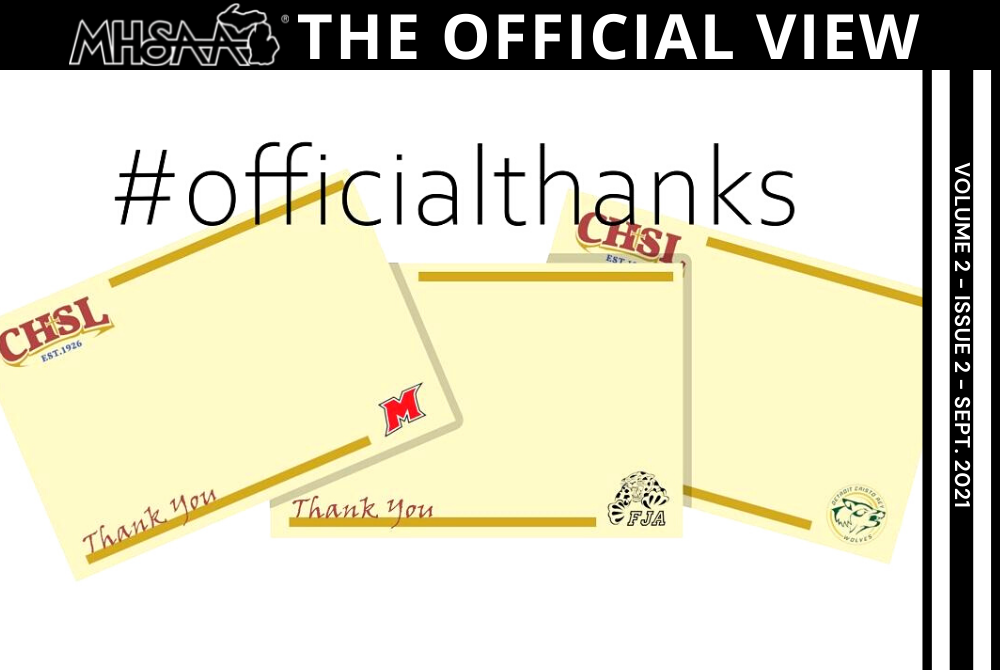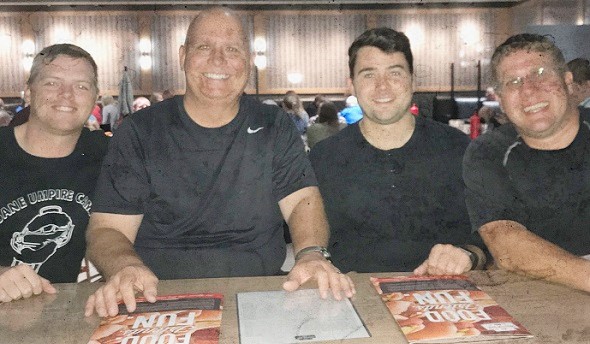
The Official View: Official Thanks
By
Brent Rice
MHSAA Assistant Director
September 13, 2021
A return to the start of another school year means a return to school sports contests – and what separates those contests from simply being kids playing a pick-up game is the attendance of assigned officials.
The steady declining trend of MHSAA registered officials was accelerated last year in the complicated world of facemasks, testing and late cancellations, when the MHSAA lost nearly 15 percent from its previous year’s ranks. Now that we have returned to some (relative) normalcy, it’s more important than ever to recognize those officials who allowed athletes to play a season last year and to welcome back those who had to take the season off.
A new program being instituted in Detroit’s Catholic High School League does just that. This year, CHSL schools will be presenting officials throughout the season with “thank you” cards to express their gratitude for the dedication and hard work these individuals provide to ensure students have an opportunity to compete.
These gestures of appreciation serve to retain officials by recognizing how important they are to the game, and to recruit new officials by showing that officiating is an honorable avocation that allows them to serve the community and stay in athletics.
The MHSAA will be rolling out a new Game Day Ambassadors Program in Spring 2022 which will include similar ideas for increasing the morale of officials and developing long-lasting, cooperative relationships between schools and officials. Some of the ways outlined include:
► “Thank an Official” events where the team and spectators recognize the officials in their community.
► Adding alternative “compensation” to officials by occasionally providing promotional items, small gift certificates from local businesses and eateries, and snacks and refreshments in the locker room.
► Presenting mid-game sportsmanship PSAs.
► Regularly reviewing officials game fees to ensure that officials are being fairly paid for their work.
The most surefire way to recruit and retain officials is to treat them with respect. The No. 1 reason given for individuals leaving officiating is negative behavior and treatment by adult spectators and coaches. These folks that give up their time to officiate school contests do so by scheduling around their day jobs, family commitments and other personal responsibilities. They are required to make real-time, split-second decisions in a world filled with zoomed in and slow-motion video, social media and camera phones at every turn, but without the luxury of replay review. And in the end, they aren’t paid nearly the amount as their college and professional counterparts.
Maintaining reasonable perspective and expectations is a core value in educational athletics … and it should be with the officials as well.
Thank you, MHSAA officials, for your commitment to school sports, and thank you to the Catholic League and others willing to acknowledge the same.
It’s Official!
Postseason Assignments: A number of changes have been instituted for postseason consideration over the past few years. Notably this year, officials in most sports must opt into tournament consideration. This means officials this season for football, soccer and volleyball must submit their availability in the MHSAA website – otherwise the default is that they are unavailable. This is in addition to other postseason requirements such as completion of the rules meeting, the tournament exam and submission of the official’s regular-season schedule through the MHSAA website. These requirements are due by Sept. 15 for soccer and volleyball, Sept. 22 for football and Oct. 6 for girls swimming & diving.
Officials Review Committee: The Officials Review Committee is scheduled to convene the first week of October to discuss issues and make proposals. Agenda items this year include volleyball and swim uniforms, video review, officials fees, sport committees including officials, registration fee deadlines and the basketball District officials assignment process. An update on these subjects will be provided in next month’s Official View.
Know Your Rules
VOLLEYBALL Team A’s server steps on the end line before contacting the ball in her serve. As she makes contact with the ball, CB (center back) and RB (right back) on Team R are overlapping.
Ruling: When the server illegally contacts the ball while in contact with the floor on the end line, the ball remains dead. Even though Team R is out of position on the play, the ball never became live, and so the foot fault is enforced and it is a loss of rally/point against Team A.
It’s Your Call
FOOTBALL This month’s It’s Your Call comes on a play from the gridiron. As Team A’s lead blocker comes around the end, Team B’s No. 17 moves up to take him on at the A 32-yard line. The ballcarrier is sprung for another eight or nine yards before being tackled. What’s the call?

The Official View: Night with the Crew
By
Brent Rice
MHSAA Assistant Director
October 1, 2018
By Brent Rice
MHSAA Assistant Director
In this week’s edition we discuss the power of our words and delivering them proactively, examine a football rule regarding rushing the punter and take a look at an “It’s Your Call” at the volleyball net.
It’s Official!
The Words We Use: Officials face criticisms regularly for their rule enforcement, judgment decisions and even positioning. As we know, these criticisms will be tossed about whether you get plays and rulings correct or not, so there is very little we can control in this area. One area we can control the criticisms we receive is the way we speak to others.
I’ve heard people say, “I’ll give them respect when they earn it.” If that’s your line of thinking, maybe you should consider giving respect simply because it’s the right thing to do. The way you communicate as an official to coaches, players and administrators reflects on you professionally, and often is a determining factor on how these parties view you in carrying out the rest of your responsibilities. If they think you’re a bad person, they often don’t give you the benefit of the doubt in close-call situations.
There are a number of books written on the art of diffusing situations through the words you use. One that immediately comes to mind is “Verbal Judo” by George Thompson. It is rather succinct and definitely worth the read. It provides much more detail on the philosophy of word usage, but let me provide you with a couple of seemingly innocuous phrases that can draw the ire of a coach and should be avoided:
“Well, that’s the rule” – Rules citation is very important when providing explanations, but simply stating that the rule says so sounds flippant and is looked at as a cop-out. Instead, start with “By rule,” then use rulebook terminology to describe the situation and ruling.
“Calm down” – While this is much better than the cringe worthy “Shut up” or “Hush” we hear being used from time to time, it still can provoke a primal urge to respond and can actually have the opposite effect of what is intended. Instead, try getting the results you desire by having them talk it through. Try statements like “All right, I’m listening to you,” or “Okay, explain to me what you’re asking.” And when using a phrase like “calm down,” trying adding an “if” statement along with it. For instance, “I’ll explain to you what I have if you calm down.”
Rule of the Week
FOOTBALL Team R loads up the box with rushers to put pressure on K’s punt deep in its own zone. As K1 punts, R1, coming from the center of the line, just gets fingers on the ball and partially blocks it. R2, from the edge, then firmly contacts the kicker’s plant leg and sends him to the ground.
Ruling: This is not a foul (in itself). The rulebook does not provide that only the player who touches the kick is excused from contacting the kicker. This exception to the rule refers only to when “the defense touches the kick.” (9-4-5-b) Of course, this does not give carte blanche to defensive players to go out of their way to unnecessarily rough the kicker just because the ball is touched.
It’s Your Call
VOLLEYBALL The clip from this week picks up after an extended volley. As Team S plays the ball over the net for its third hit, a front row member of Team R makes a play on the ball. The questions is, are the two contacts by the front row R player legal? Why or why not?
Last Week’s IYC Ruling: The basic spot on the play is the end of the run. Using the all-but-one principle, this foul would be penalized from the spot of the foul (A’s 35). If the defense accepts the penalty, it would be A’s ball, 3rd-and-27 on A’s 20. If the defense declines, it would be 4th-and-8 on A’s 39. This is definitely an instance that you want to run the options by B’s coach before enforcing the penalty. (Click to see the video from last week.)
Official View
After a long, hard-fought Friday night contest between Rockford and Greenville, crew members (left to right) Dale Feutz, Brian Donovan, Sam Boland, and Luke Griemsman stop in at a local Rockford eatery to discuss the night’s game over a meal.

